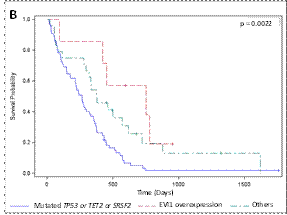Abstract

BACKGROUND:
AML in elderly patients, secondary AML and/or AML with complex karyotype respond poorly to conventional intensive chemotherapy (CT) and have a poor prognosis. In those patients, however, AZA can bring some benefit, especially in the absence of adverse cytogenetics, if WBC < 15 × 10⁹/L and performance status (PS) < 2 (Thepot, Am J Hemat, 2014; Pleyer Ann Hematol, 2014). Whether molecular findings can predict outcome in AML receiving first line AZA (as they do in AML receiving CT) is however unknown.
PATIENTS AND METHODS:
96 AML patients who received between 2007 and 2012 first line treatment with AZA (75mg/m2/d x 7 d/4 weeks SC for a median of 7 cycles, range 1-33) in 8 French centers were retrospectively analyzed. Initial response was evaluated based on blood and marrow examination after 4 -6 cycles of AZA. We analyzed the impact on overall survival (OS) of conventional clinico-biological parameters, and molecular biology parameters including EVI1 expression, MLL-PTD, and the mutational status of 16 genes analyzed by next-generation sequencing (NGS) and Sanger sequencing: ASXL1, CEBPA, DNMT3A, EZH2, FLT3, IDH1, IDH2, NPM1, NRAS, KRAS, RUNX1, SF3B1, SRSF2, U2AF1, TET2, and TP53.
RESULTS:
Median age was 73 (range, 44-88). Median PS was 1 (range, 0-3). 55% patients had secondary AML, including post MDS or MPN AML (N=39), and therapy related AML (N=14). 64% of patients had high risk cytogenetics and only 14 normal karyotype. Median WBC was 3.87 G/L and 28 patients had WBC >10 G/L. Median platelets and Hb were 61 G/L and 9.25 g/dL respectively. 41 and 55 patients had marrow blasts < 30% and ≥ 30% respectively, and median circulating blast % was 15% (range, 0-95). The median number of somatic mutations per patient was 2 (range, 0-5). The most frequently mutated genes were TP53 (40%), TET2 (22%) and SRSF2 (19%), then DNMT3A (14%), ASXL1 (13.5%), IDH2 (11%) and RUNX1 (11%). EVI1 overexpression (defined stringently in this study as DD CT ≤ 8 EVI1/ABL) was found in 12 patients. Overall response rate was 29% (14% CR, 8% PR and 7% Cri), and median response duration was 9.4 months. Median OS was 10.9 months. In univariate analysis, the following factors were significantly associated with shorter OS: platelets and Hb below median (p<0.0001 and p=0.0007 respectively), PS≥2 (p=0.008), and circulating blasts as continuous variable (p=0.03) while WBC and cytogenetics had no significant impact.
OS was significantly worse in patients with TP53 gene mutation (median 8.9 vs 12.3 months in unmutated cases, p=0.01). It tended to be worse for SRSF2 gene mutation (median 8.4 vs 11.5 months, p=0.16) and TET2 gene mutation (median 8.8 vs 11.7 months, p=0.20) and tended to be better in patients with EVI1 overexpression (median 16.1 vs 9.4 months in other patients, p=0.17), while the mutational status of ASXL1, DNMT3A, IDH2 and RUNX1 genes had no impact on OS.
Median survival of patients with at least one mutation of TP53, TET2, SRSF2 genes, was 9.1 vs 14.8 months if the 3 mutations were absent (p=0.0008, figure A). In multivariate analysis (logistic regression according to the Wald method), higher PS (p=0.0061), lower Hb (p=0.0014), lower platelets (p=0.0139) higher % circulating blasts (p=0.0145) and presence of TP53, TET2 or SRSF2 mutation (p=0.0035) were associated with poorer OS. Due to the low number of patients with EVI1 overexpression, this parameter was not included in the multivariate analysis. However, the 7 patients with EVI1 overexpression without any poor prognostic mutation had a median OS of 25.1 months ,versus 8.8 in patients carrying TP53, TET2 and/or SRSF2 mutations and 12.6 months in remaining patients without EVI overexpression (p=0.022) (figure B).
CONCLUSION:
In this first analysis (to our knowledge) of the prognostic value of molecular factors in poor risk AML (55% secondary cases, 64% unfavorable karyotype) receiving first line treatment with AZA, mutations of the TP53 and to a lesser extent TET2 or SRSF2 genes were adverse prognostic factors, and added prognostic value to conventional clinical and hematological parameters. For TET2, the effect seemed different from the favorable prognosis observed in MDS treated with AZA (Itzykson, Leukemia, 2011; Sekeres, Blood, 2012). Surprisingly also, EVI1 overexpression, a poor prognostic factor in AML, seemed associated with better outcome with AZA treatment in the absence of any poor prognostic mutation Those findings will require confirmation in larger prospective series.
No relevant conflicts of interest to declare.
Author notes
Asterisk with author names denotes non-ASH members.

This icon denotes a clinically relevant abstract



This feature is available to Subscribers Only
Sign In or Create an Account Close Modal